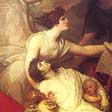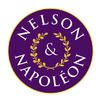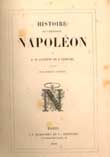| |
| |
THIS MONTH'S PAINTING
The Immortality of Nelson, by Benjamin West (1807)
Horatio Nelson, who had recently died at the Battle of Trafalgar, 21 October, 1805, came to be seen as a model of patriotic duty and was celebrated as such by British painters and poets alike - his funeral, January 1806, at St Paul's cathedral in London was remarkable for its pomp and show. Born in the English colony of Pennsylvania in 1738, Benjamin West set up in London in 1763 after having spent a time in Italy, where he had discovered nascent Neo-classicism. A founding member of the Royal Academy and its president for thirty years, he was George III's official artist and protégé.

|
|
|
| |
NELSON AND NAPOLEON
As part of the festivities marking the bicentenary of the battle of Trafalgar and the death of Nelson, Queen Elizabeth II reviewed an international fleet of more than 160 vessels gathered in the Solent (between the port of Portsmouth and the Isle of Wight) on Tuesday 28 June. In the evening a 'son et lumière' show replayed the battle (on the television it was however very difficult to see anything at all, apart from the magnificent fireworks display), this time with red against blue.
At the National Maritime Museum in London, Nelson and Napoleon meet face to face (possibly for the first time) in an exhibition which opens on 7 July: this exhibition aims to explore the way in which the two men became legendary figures. It also attempt to show the impact of the French Revolution and Napoleon on British society. And finally it is an occasion to study in detail the Battle of Trafalgar, its course of events and its consequence, in both the short and long term: Nelson's manuscript battle plan is one of the 'jewels' of the exhibition.
For further reading on this subject, see:
the article The British Navy, 1793-1802, by Peter Hicks
- the articles by Philippe Masson, Napoleon and England,
Part I : NAPOLEON AGAINST THE ENGLISH NAVY (1797-1805)
and
2: ENGLISH NAVY AND ARMY AGAINST NAPOLEON (1805-1815)
For a biography of Nelson, see the web site of the Royal Navy

|
|
|
| |
NEW SECTION
"Napoleonic pages" is a new section napoleon.org: every month, we will suggest the rediscovery of an book published in the 19th or early 20th centuries dealing with the history of the First or Second Empire held at the Bibliothèque M. Lapeyre – Fondation Napoléon.
We begin this section with one the most illustrated works on Napoleon published by the Paris press J.-J. Dubochet in 1839: Histoire de l'Empereur Napoléon by Laurent de l'Ardèche, with vignettes, illuminated capitals, and unpaginated engravings by Horace Vernet.
For further information on this section, contact Chantal Lheureux-Prévot.

|
|
|
| |
200 YEARS AGO
On 15 Messidor, An XIII (4 July, 1805), General Armstrong, United States Minister, organised a grand dinner for the French officers who participated in the American War of Independence.
From 11 to 17 Messidor, An XIII (30 June - 6 July, 1805), Napoleon stayed in Genoa, where he visited the port, the fortifications and the contrusction projects. Then he headed north to turin where he stayed two days before heading once again for Paris.
On 16 Messidor, An XIII (5 July, 1805), Napoleon sent to Berthier a report of his inspection visits in Italy: "The artillery situation in Italy is alarming; [...] the fortress in Genoa has a large quantity of poor quality bronze, a great number of cannonballs, most of which the wrong calibre, and almost no gun carriages. All the fortresses in Italy lack gun carriages, even the field trains. All the artillery teams in Alessandria and other fortresses also lack gun carriages. [] The main problem for the artillery corps is that instead of correct calibre cannon balls, they have them one calibre smaller; this can only produce a poor result."
Napoleon planned to ask Jean-Jacques-Basilien Gassendi (1748-1828) to give him a precise report of the strength of the field gun and siege gun teams in Italy. Son of a lawyer in the parliament in Aix, and related to the scholar philosopher Pierre Gassendi (1592-1655), Gassendi decided rather to enter the artillery in 1767, and it was in the La Fère regiment that he got to know the young gunner lieutenant Bonaparte. As the man in charge of the artillery park of the Armée de réserve, he was showed his skill in the crossing of the Grand-Saint-Bernard pass. He then became commander of the Auxonne military school in 1802. He received many honours during the Empire (member of the Légion d'honneur on 11 December, 1803, Commandeur on 13 June, 1804, Inspector general of the artillery on 14 March 1805, Général de division on 20 September, 1805, Conseiller d'État on 11 February, 1806, Comte de l'Empire on 9 December 1809, Grand-Officier of the Légion d'honneur on 30 June, 1811, Grand-Croix of the Ordre de la Réunion on 3 April, 1813, and senator on 5 April, 1813.), and despite the fact that he voted for Napoleon impeachment in 1814, he was nevertheless made a peer during the Hundred Days. After a brief period in disgrace during the Restoration, her returned to the Senate in 1819.
150 YEARS AGO
From 2 to 13 July, the Corps Législatif had an extraordinary meeting to vote for a loan of 750 million francs to finance the Crimean War.
On 5 July, 1855, Jacques Offenbach presented to the public a new show, L'Arlequin Barbier (The Harlequin Barber, a comic ballet in one act), in the recently opened theatre on the Champs-Elysées, the Bouffes-Parisiens, built on the site of a old disused theatre.
Wishing you an excellent, Napoleonic, week!
Peter Hicks
Historian and Web editor
Interested in the work of the Fondation Napoléon? Why not participate, either generally or in a specific project, by making a donation.
© this Napoleon.org weekly bulletin is published by the Fondation Napoléon. Reproduction or all or part of this bulletin is forbidden, without prior agreement of the Fondation Napoléon.

|
|
|
|
|
|
|
|
|
|
|
|
THIS WEEK
WHAT'S ON
- Exhibition: Nelson and Napoleon, National Maritime Museum, London, UK
- Exhibition: Il rifugio di Venere. La Villa Paolina Bonaparte, Viareggio, Italy
- Conference: War at Sea in the age of Nelson, The Trafalgar Bicentennial Conference, Christ Church, Oxford, UK
- Conference: Europe at War: the Trafalgar campaign in context, Senate House, London University, UK
- Conference: The Battle of Trafalgar Conference, at Action Stations, Portsmouth Historic Dockyard, UK
- For Napoleonic and Nelsonian 2005 bicentenaries, watch our 2005 bicentenaries page
THE MONTHLY TITLES
- This month's book: HILL, Peter P., Napoleon's Troublesome Americans: Franco-American Relations, 1804-1815
- This month's painting: The Immortality of Nelson, by Benjamin West (1807)
- This month's article: O'Meara's account of Napoleon and his invasion of the England
- In the Collectors Corner, Bonaparte, First Consul, distributing honour sabres to the grenadiers of his guard after the Battle of Marengo, 14 June 1800
Got a problem with a link in the letter? Try the homepage
<<
|
|



